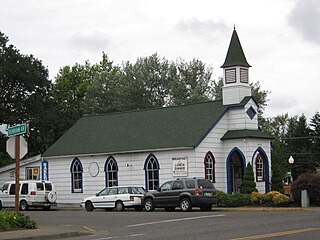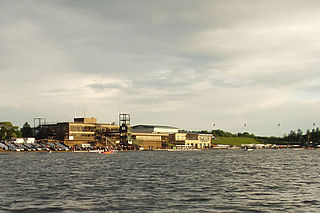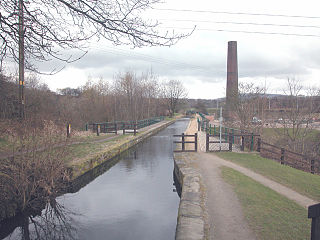
Dartmoor is an upland area in southern Devon, England. The moorland and surrounding land has been protected by National Park status since 1951. Dartmoor National Park covers 954 km2 (368 sq mi).

The Peak District is an upland area in England at the south end of the Pennines. Mostly in northern Derbyshire, it includes parts of Cheshire, Greater Manchester, Staffordshire, West Yorkshire and South Yorkshire. It can be split into the Dark Peak, where most moorland is found and the geology gritstone, and the White Peak, a limestone area of valleys and gorges cutting through the limestone plateau. The Dark Peak forms an arc on the north, east and west sides; the White Peak covers the central and southern tracts. The historic Peak District is larger than the area of the National Park, which excludes major towns, quarries and industrial areas. It became the first of the national parks of England and Wales in 1951. Nearby Manchester, Stoke-on-Trent, Derby and Sheffield send millions of visitors a year. Some 20 million people live within an hour's journey. Inhabited from the Mesolithic era, it shows evidence from the Neolithic, Bronze and Iron Ages. Settled by the Romans and Anglo-Saxons, it remained largely agricultural; mining arose in the Middle Ages. Richard Arkwright built cotton mills early in the Industrial Revolution. As mining declined, quarrying grew. Tourism came with the railways, thanks to the landscape, spa towns at Buxton and Matlock Bath, Castleton's show caves, and Bakewell, the park's one town. Walking, cycling, rock climbing and caving are popular.

Veneta is a city in Lane County, Oregon, United States. As of the 2010 census, the city population was 4,561.

Cheddar Gorge is a limestone gorge in the Mendip Hills, near the village of Cheddar, Somerset, England. The gorge is the site of the Cheddar show caves, where Britain's oldest complete human skeleton, Cheddar Man, estimated to be 9,000 years old, was found in 1903. Older remains from the Upper Late Palaeolithic era have been found. The caves, produced by the activity of an underground river, contain stalactites and stalagmites. The gorge is part of a Site of Special Scientific Interest called Cheddar Complex.

The tufted duck is a small diving duck with a population of close to one million birds, found in northern Eurasia. The scientific name is derived from Ancient Greek aithuia an unidentified seabird mentioned by authors including Hesychius and Aristotle, and Latin, fuligo "soot" and gula "throat".

Bolton is a large town in Greater Manchester in North West England, historically and traditionally a part of Lancashire. A former mill town, Bolton has been a production centre for textiles since Flemish weavers settled in the area in the 14th century, introducing a wool and cotton-weaving tradition. The urbanisation and development of the town largely coincided with the introduction of textile manufacture during the Industrial Revolution. Bolton was a 19th-century boomtown and, at its zenith in 1929, its 216 cotton mills and 26 bleaching and dyeing works made it one of the largest and most productive centres of cotton spinning in the world. The British cotton industry declined sharply after the First World War and, by the 1980s, cotton manufacture had virtually ceased in Bolton.

Carsington Water is a reservoir operated by Severn Trent Water located between Wirksworth and Kniveton in Derbyshire, England. The reservoir takes water from the River Derwent at Ambergate during winter months, pumping up to the reservoir by 10.5-kilometre (6.5 mi) long tunnels and aqueduct. Water is released back into the river during summer months for water abstraction and treatment further downstream. It is England's ninth largest reservoir with a capacity of 35,412 megalitres.

Holme Pierrepont Country Park, home of The National Water Sports Centre is located in the hamlet of Holme Pierrepont near Nottingham, England and on the River Trent. It is used for many different types of sports and has recently received significant investment which has enabled a major refurbishment of existing facilities as well as introduction of new facilities.

Edgbaston Reservoir, originally known as Rotton Park Reservoir and referred to in some early maps as Rock Pool Reservoir, is a canal feeder reservoir in Birmingham, England, maintained by the Canal & River Trust. It is situated close to Birmingham City Centre and is a Site of Importance for Nature Conservation.

Hollingworth Lake is a 130-acre (53 ha) reservoir at Smithy Bridge in Littleborough, Greater Manchester, England. It was originally built as the main water source for the Rochdale Canal, but developed as a tourist resort from the 1860s. Hotels were built around it, helped by the arrival of the railway in 1839, which brought day-trippers and weekend visitors from Manchester, Bradford and Leeds.

The Brent Reservoir is a reservoir in North West London. It straddles the boundary between the boroughs of Brent and Barnet and is owned by the Canal & River Trust. The reservoir takes its informal name from a public house called The Welsh Harp, which stood nearby until the early 1970s. It is a 68.6-hectare (170-acre) biological Site of Special Scientific Interest (SSSI), the only SSSI in either Borough and among more than 30 SSSIs in Greater London.

Rivington is a village and civil parish of the Borough of Chorley, Lancashire, England, occupying 2,538 acres. It is about 6 miles (9.7 km) southeast of Chorley and about 8+1⁄2 miles (13.7 km) northwest of Bolton. Rivington is a rural area consisting primarily of agricultural grazing land, moorland, with hill summits including Rivington Pike and Winter Hill within the West Pennine Moors. The area has a thriving tourist industry centred around reservoirs created to serve Liverpool in the Victorian era and Lever Park created as a public park by William Lever at the turn of the 20th century, with two ancient barns, a replica of Liverpool Castle and open countryside. Rivington and its village had a population of 109 at the 2011 Census.

The West Pennine Moors is an area of the Pennines covering approximately 90 square miles (230 km2) of moorland and reservoirs in Lancashire and Greater Manchester, England. It is a Site of Special Scientific Interest.

Wimbleball Lake on Exmoor in Somerset, England, is a water supply reservoir constructed in the 1970s and completed in 1979.

Burrs Country Park covers a 36 hectare site located on the banks of the River Irwell, 1.5 km north west of Bury, Greater Manchester. It was acquired by Bury Metropolitan Borough Council in 1986 and transformed from a derelict industrial site into a modern country park. Access to the park which is open all year round is via Woodhill Road.

Llanishen Reservoir is a Victorian reservoir in North Cardiff in Wales. The reservoir is one of the reservoirs constructed as part of the Taff Fawr scheme for supplying water to Cardiff and was completed in 1886. It forms part of the Nant Fawr Corridor from the top of Roath Park to the countryside beyond Cyncoed.

The Jumbles Reservoir is a heavily modified, high alkalinity, shallow reservoir in North West England. It lies in Jumbles Country Park, in the valley of Bradshaw Brook, partly in the Metropolitan Borough of Bolton, Greater Manchester, and partly in Blackburn with Darwen, Lancashire. It was opened on 11 March 1971 by Queen Elizabeth II for the then Bolton Corporation Waterworks. The reservoir's original purpose was to guarantee water for the Croal-Irwell river system and the associated industries.

Rumworth Lodge Reservoir is a large shallow reservoir in Bolton, Greater Manchester, England.

Upper and Lower Black Moss Reservoirs are reservoirs close to the village of Barley, in the Borough of Pendle, close to the market town of Burnley, England. The reservoirs provide drinking water to Nelson when needed.

Khandoli Dam is a dam located 10 km North-East of Giridih town towards Bengabad in Jharkhand, India. Khandoli is also an important tourist spot at the foot of the Khandoli hill. The reservoir of the Khandoli dam provides water supply to more than one lakh residents of the Giridih city.





















